Here are 16 ways to bring new life and renewed business purpose to your Twitter efforts.
#1: Organize whom you follow with lists
There are many people you need to follow on Twitter for business reasons such as customers, suppliers, neighboring businesses, peers and competitors. As the number of people you follow grows, so does the noise. It gets harder to hear the important messages among all of the others.
So how can you make sure you don’t miss anything important? Use Twitter lists.
Twitter lists are its most powerful and least-used feature. Lists allow you to group the important people you follow so they don’t get lost in the noise of everyone else.
You can create separate lists for:
- Customers
- People in your industry
- Social media teachers
- People in professional organizations
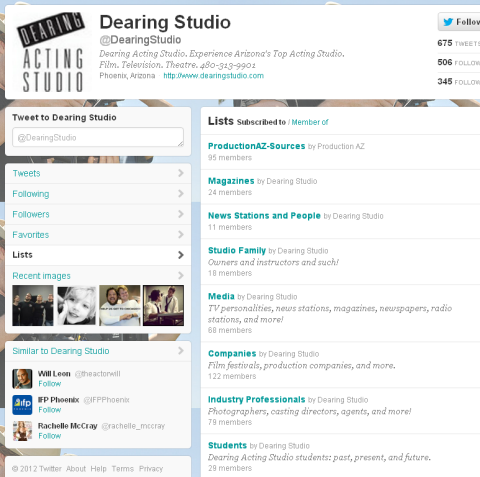
You can create Twitter lists to organize the people you follow so you can focus on the most important people and conversations.
By creating and using Twitter lists, you can focus on tweets from groups of people and decide when you want to see them, so tweets from important people don’t get lost.
You can create up to 20 different Twitter lists with up to 500 accounts in each list. You can monitor each list separately using Twitter.com or Twitter tools like HootSuite.
Tip: You don’t have to put everyone into a list.
#2: Create a conversation list
Whom you follow determines your daily experience of Twitter. If you follow people who inspire you, people who say intelligent things and challenge you to think differently, Twitter becomes a joy.
One smart way to focus on the people who inspire you (without ignoring everyone else) is to create a private conversation list.
Include in this list:
- People who inspire you in business
- People who inspire you personally
- People who are fun to talk with
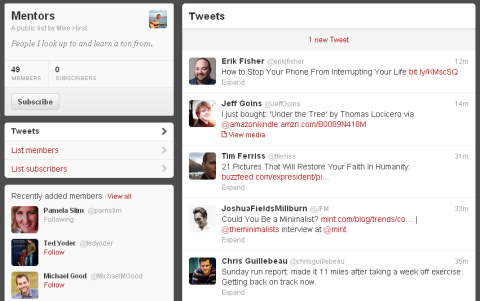
A conversation list helps you save time by pulling together the most important people and conversations into a single list.
Jump into the list when you are looking for inspiration or encouragement during your workday.
You can make your conversation list public or private. By creating a private list, you are the only person who knows who is on your list and when you make changes to the list. However, everything you say to people on this list is still public, so watch your words.
#3: Update your profile picture
Your Twitter profile picture appears next to every tweet you send. It’s an opportunity to associate an image with your business in the minds of everyone who follows you.
The challenge is that your Twitter profile picture is very small and square. For most businesses, your logo or personal headshot isn’t the right size or shape to represent you well.

At full size, this company may have a beautiful logo. However, it’s too small to be effective on Twitter.
If your profile picture is your logo:
- Make sure your logo fits into the square size. Cropped-off logos look unprofessional and give the impression that your business doesn’t care about the details.
- Make sure your logo is readable. If your logo contains words that cannot be read, you are wasting the space. Create an image without the words that captures the essence of your logo.
- Consider switching to a headshot. People connect with faces, not logos. If you are the driving force of your business, why not use your face to make your business seem more human and approachable?

This is an example of what not to do with your Twitter profile picture because you cannot easily see the person’s face.
If your profile picture is a photograph:
- Focus on your face. People don’t want to see you standing on the beach and they don’t care what clothes you are wearing.
- No animals or kids. Even if your business is directly related to pets or children, you should be the focus of your photograph. You want to make a human connection with potential customers.
While a professional photograph is ideal, you can have a friend use a camera to take a great shot of your face. Make sure you are photographed against a plain background, and don’t forget to smile. Take 20 or more shots so you can choose one that really captures you.
If you don’t have the skills to change your logo or crop your photo to the right shape, ask a friend or hire a graphic designer for an hour. The small investment will pay huge dividends in having a professional presence on Twitter.
#4: Change your visual branding
Twitter allows you to customize the look and colors of your Twitter profile page. This gives you an opportunity to provide additional information about your business to everyone who checks out your profile.
You can create a custom graphic and use it for your Twitter background.
Here are some great examples of Twitter backgrounds and instructions for how to create your own.
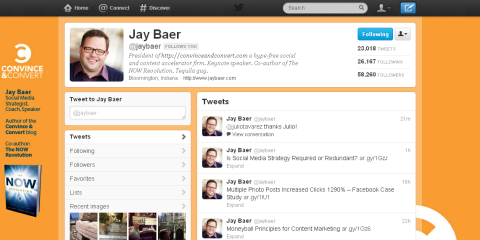
Here is an example of a custom Twitter background that highlights important company information and provides additional details.
After you create the image file, you upload it to your profile. While you are there, you can adjust the background and link colors so they coordinate with your new background image. You will need the hex codes for the colors in your image if you want the background and links to match.
#5: Rewrite your Twitter bio
Your Twitter profile bio tells your business story in the length of a text message. That’s a lot of information crammed into just a few words.
The best Twitter profiles include these components:
- Tell people what you do
- Explain how you help people
- Show a little personality

A good Twitter bio explains what you do and shows your personality at the same time.
Look at your business Twitter profile with fresh eyes. Then rewrite it so it tells potential customers how you can help them and what benefit they can get from connecting with you. And don’t forget to share a little of your passion!
Mark your calendar to review and update your Twitter bio again in 6 months, because even the best bio gets stale over time.
#6: Create a Twitter landing page
Are you frustrated by only having 160 characters for your Twitter bio? Then consider creating a special Twitter landing page.
Most people use their Twitter profile web link to drop people off at their website front door or their blog. But you can create a special Twitter landing page and use that page as your Twitter profile web address.
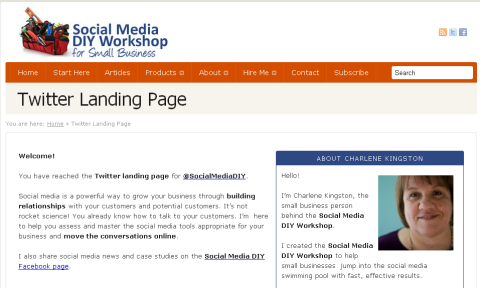
A Twitter landing page gives you more space to talk about your business and about your Twitter use.
A Twitter landing page is a special page on your website designed to introduce people from Twitter to your business. It’s like having a greeter there to help people get the scoop on your business and how you use Twitter.
Your Twitter landing page could include:
- A personal message from you
- Details about your business products and services
- How to become a customer
- What you tweet about
- The people behind your Twitter account
Even though you have more space, keep your Twitter landing page short and to-the-point to make a great impression on your visitors.
#7: Rethink your follow strategy
Many Twitter accounts are not run by real people. They are automated programs called bots. And some of them are spammers.
There are bots that provide useful information. However, most bots are spewing out tweets from other people and other sources that are not on target for your Twitter business goals. They clog up your Twitter stream and don’t provide any business value.
You may not have known you were following a bot. Bots gain an audience by following many people and taking advantage of people who automatically follow back.
In general, it’s better not to follow automatically everyone who follows you if you want to avoid having your Twitter stream fill up with garbage.
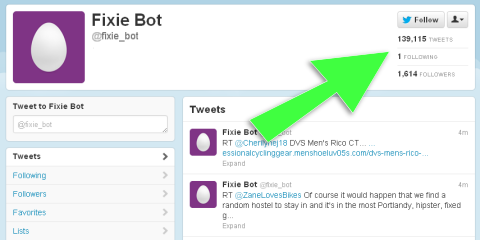
Bots usually have low numbers they follow with high numbers following them back like this account.
So how can you spot a bot or spammer or someone whom you should not follow back?
Here are a few suggestions:
- Don’t follow people with an egg picture. If they haven’t bothered to upload a real profile picture, chances are they are not going to say anything worth hearing.
- Check their numbers. An account that follows many people but has only a few followers is probably a spammer.
- Review their tweets. Are they all retweets or quotes? Did they send the exact tweet to many users over a very short time? It’s probably a bot.
- They say it’s a bot in their bio. Yes, some bots will tell you they are bots in their bio.
- No favorite tweets or lists. A bot or spammer doesn’t mark tweets as favorites or create lists.
#8: Listen carefully and follow
Social media is all about conversations, and conversations mean that you talk and listen.
On Twitter, you can listen by:
- Reading tweets. This is the best way to find out what is on the minds of your Twitter community.
- Look for replies and mentions. Every time you check Twitter throughout the day, you should first check for direct messages and mentions. Mentions are public messages that include your Twitter handle and direct messages are private messages sent directly to you.
- Search for your business name. Sometimes, people talk about your business without using your Twitter username. You should regularly check Twitter for people who mention your business name by creating a search and saving it.
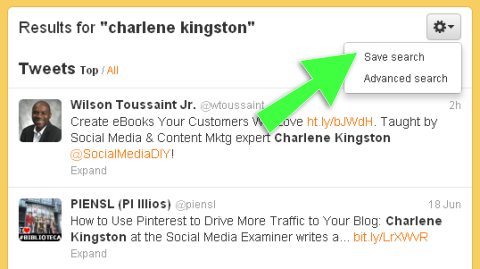
When you see the search results page, click the gear icon to save the search.
You should follow everyone who talks to you on Twitter. So as you find people talking about your business or talking directly to you, follow them.
#9: Publicize your Twitter account
Make it easy for people to find your business on Twitter by adding your Twitter username to all of your business materials.
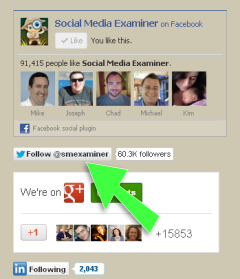
Make it easy for people to follow your business on Twitter by posting a Twitter Follow button on your website or blog.
For example, you should give your Twitter username in these locations:
- Your website (with a link)
- Your email signature (with a link)
- Your email newsletter (with a link)
- Your business cards
- Signs posted in your business
- Paperwork you give customers (receipts, invoices, statements, etc.)
- Menus and product information sheets
#10: Make sure you are following your customers
Twitter is a great place to talk with your customers. However, this means that you have to connect with them.
It’s impossible for you to know which of your customers are on Twitter. For that reason, it’s important for you to advertise your Twitter account to your customers. This way, your customers can find you.
How can you tell who is your customer on Twitter? Here are a few tips:
- They talk to you. Some customers may start a conversation with you using your Twitter handle. You should follow everyone who talks to your business.
- They mention your business. You should set up a saved search on Twitter so you can find people talking about your business. Always reply to people who mention your business and follow them.
You can also search for your customers using their email address from your address book.
#11: Stop following people who don’t tweet
In general, don’t worry about trying to control who follows you. But it’s a good idea to prune out the followers who have stopped using Twitter.
A great free tool for finding people who haven’t tweeted for a while is unTweeps. After you authorize the app, it allows you to create a list of your followers based on how long since their last tweet. You can use the free account three times each month.
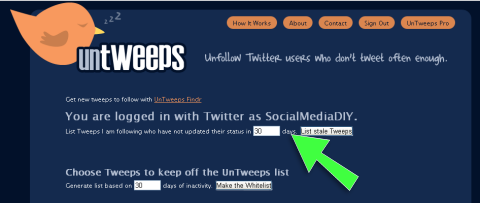
The unTweeps screen allows you to create a list of people you follow based on the number of days since their last tweet.
Start with people who haven’t tweeted for 6 months (or even 9 months) and review the list. You can mark individual accounts to unfollow.
Tip: If you have a large number of people who are no longer tweeting, don’t unfollow them all at the same time. This action can signal Twitter to suspend your account for aggressive and spammer-like behavior.
#12: Put Twitter to work solving your business challenges
Sometimes, the best way to improve your experience with a tool is to ask more from it. If you’ve been casually using Twitter and allowing the results to unfold, maybe it’s time to give Twitter a real job.
It takes some time using Twitter before you’ll be ready to put it to work on your business goals. But after you understand Twitter and have built a community, it’s time to take your Twitter use to the next level.
Twitter can help you meet your business goals. Think about a challenge you face in your business today. How could Twitter help you solve that problem?
For example:
- Offer a Twitter-only special. If your restaurant or store is a ghost town on Tuesday nights, why not promote a Tuesday night event on Twitter? Offer a special deal (free dessert or a special discount) for everyone who knows the secret code you tweet out Tuesday at 5 pm.
- Reward people who retweet you. Is your blog a little lonely? Twitter is a great tool to drive traffic to your blog. Set up a contest or a reward for people who retweet your messages about your blog posts. You might give away an ebook, a seat at an upcoming webinar, a free 30-minute consultation or a product discount. Explain the terms of the offer in a blog post or on a special website page and link to that page in your tweet so people understand your offer.
- Organize a tweetup at your business. Have you been chatting with local people whom you have not met in real life? Or has it been a long time since they have visited your business? Why not organize an informal tweetup? Set a date and time, offer refreshments and give people something fun to do or learn and they will come.

NASA has started using tweetups to reward key followers in its social media community.
The best way to make Twitter work for your business is to try something new. Learn from what happens and try it again with improvements.
#13: Add photos to your tweets
People love pictures. And this year, social media has really expanded to give people more of what they want.
Statistics show that people are more likely to read your stuff online if you include pictures. This means that just by adding photos to your tweets, you can greatly increase the amount of attention they get.

Adding a photo to your tweet increases the number of people who will interact with your message.
The best part is that your photos don’t have to be professional-quality to be effective on Twitter. You can use your smartphone camera to snap a picture, and then use the Twitter mobile app for your phone to tweet and upload your picture.
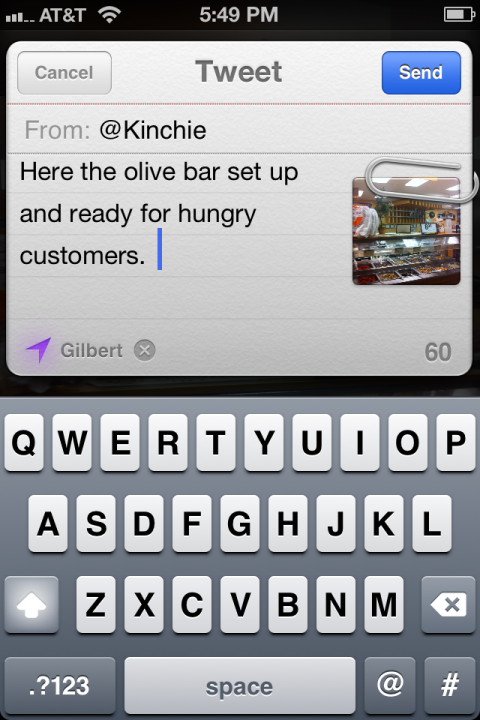
Every mobile Twitter app makes it easy to attach a photograph to a tweet from your smartphone.
#14: Bookmark tweets you want to keep
Did you know that every tweet has its own web address?
You can save important tweets using the Favorites feature. However, many businesses use the Favorites as part of their Twitter strategy, and so they need another way to save tweets.
To get to the web address of any tweet:
- Display the tweet on your screen.

The Expand command displays more tweet options. - Click Expand. Twitter provides more tweet options.

The Details command displays the tweet in its own web page. - Click Details. Twitter displays the tweet on its own page using its unique web address.

An example of a tweet displayed on its own page using its unique web address. - Bookmark the tweet using your browser or bookmarking tool.
You can bookmark important tweets using your browser’s bookmarking tool or a web-based bookmarking service like Delicious. Now you have a way to keep track of important tweets so you can use them in the future.
#15: Review (and renew) your tweet topics
When most businesses start using Twitter, they experiment for a while. As a result, they often tweet about random topics, or don’t tweet very often because they don’t know what to say.
After mastering the basics of Twitter’s message types and building out your online community, it’s time to get serious about your conversation topics. Or to use marketing terms, it’s time to develop a content strategy.
Every business has a core group of topics around its products and services. These are things that you know because of your business, and things that your customers and online community want to learn from you. Often, you educate your customers about these topics.
Many businesses struggle to find these topics because they take their knowledge for granted. With a little effort, you can start to see your business knowledge through the eyes of your customers and figure out the topics that really spark interest in your community.
These are the topics you should focus on with Twitter and social media in general. In fact, if you have a blog, these should be your blog categories.
Brainstorm a list of 5 to 7 conversation topics, and then create a list of 10 or more specific things within each category. These will help you organize your Twitter conversation and will spark ideas when you can’t think of anything to say.
Pay special attention to tweets that are retweeted, get replies or are marked as favorites. Those tweets hit a nerve, and you should talk more about those topics.
Note: The best Twitter topics for your business are things that provide practical solutions to problems your potential customers face every day.
#16: Expand the Twitter conversation to your blog
When you have a great conversation going on Twitter, or you find a topic that people respond to on Twitter, why not expand the conversation to the people who read your blog?
Twitter now makes it easy for you to embed a tweet into a blog post so it looks like a tweet and has the same interactive features it has on Twitter. In other words, you can write a blog post around a tweet and your blog visitors can interact with you on Twitter through your blog.
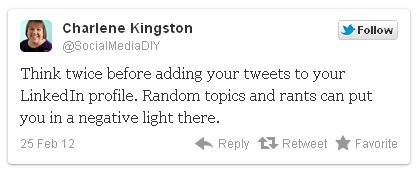
An example of a tweet conversation-starter posted in a blog.
What do you think? How have you made Twitter more relevant and more vital to your daily business operations? What strategies and tactics have you used? Share your insights and experiences in the comments box below.
Source
Source

No comments:
Post a Comment